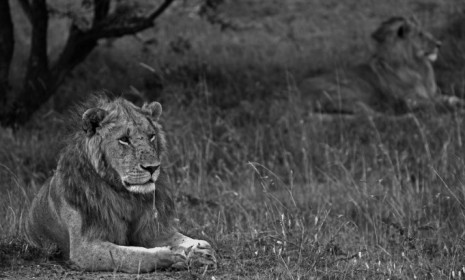Africa's big animal problem
Why are the populations of Africa's most iconic animals — lions, giraffes, zebras, and others — plummeting? And what's being done to stop it?

Populations of many of Africa's most beloved large mammals — lions, zebras, buffalos, and dozens more species — are plummeting inside the very wildlife parks that are meant to protect them. A new British study found that large animals have declined in numbers by nearly 60 percent across the continent since 1970:
What exactly did the study find?
Looking at 68 key species in 78 protected parks across Africa, the study found that populations of large mammals — including lions, zebras, and giraffes — had fallen 59 percent, on average, from 1970 to 2005. Parks in West Africa were the worst hit, with an average population decline of 85 percent. "The results are far worse than we imagined," says Jonathan Baillie, the director of ZSL conservation programmes.
The Week
Escape your echo chamber. Get the facts behind the news, plus analysis from multiple perspectives.

Sign up for The Week's Free Newsletters
From our morning news briefing to a weekly Good News Newsletter, get the best of The Week delivered directly to your inbox.
From our morning news briefing to a weekly Good News Newsletter, get the best of The Week delivered directly to your inbox.
Is this happening all over Africa?
No, the study found that some animal populations were actually growing in the south of the continent. University of Cambridge conservation scientist Ian Craigie, who headed up the study, says "southern African parks are much better funded than parks across the rest of Africa. They're better managed, have more staff and so are better at defending against poachers and other threats." The researchers only looked at animals inside wildlife parks and reserves, which cover about 15 percent of the continent. The situation outside the parks is almost certainly much worse.
Why is this happening?
Poaching and lost of habitat are the main culprits. The hunting culture in Africa remains strong, and locals often hunt illegally for bushmeat inside wildlife parks, many of which lack the resources to adequately protect animal populations. "There are literally hundreds of national parks in Africa," says Craig. "Most do not monitor their animals enough." Aerial surveys tend to be the most accurate — but also most expensive — means of monitoring.
A free daily email with the biggest news stories of the day – and the best features from TheWeek.com
Have any other recent studies found similar data?
Yes. A study conducted between 1989 and 2003 of Kenya's Masai Mara reserve, a popular tourist destination for safaris, found that the local giraffe population had declined by 95 percent during that period. The study also showed enormous declines for warthogs (80 percent) and hartebeest (76 percent). "The situation we documented paints a bleak picture and requires urgent and decisive action if we want to save this treasure from disaster," the lead author of that study, Joseph Ogutu said, as quoted in The Guardian.
What's the biggest worry?
Millions of tourists visit Africa each year to go on safari and see the country's notorious big game. If the parks lose too many of their animals, tourism and related industries will decline, and it could create a vicious cycle, whereby the parks have even fewer resources to protect declining animal populations. Craigie, however, is hopeful that if African parks can find outside sources of funding, the situation can still be turned around.
Sources: Guardian, Christian Science Monitor, Planet Earth
-
 Who is fuelling the flames of antisemitism in Australia?
Who is fuelling the flames of antisemitism in Australia?Today’s Big Question Deadly Bondi Beach attack the result of ‘permissive environment’ where warning signs were ‘too often left unchecked’
-
 Bulgaria is the latest government to fall amid mass protests
Bulgaria is the latest government to fall amid mass protestsThe Explainer The country’s prime minister resigned as part of the fallout
-
 Codeword: December 15, 2025
Codeword: December 15, 2025The daily codeword puzzle from The Week